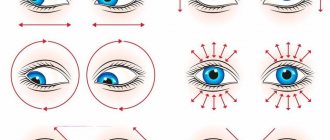Color blindness is a disease that affects the organs of vision and affects the visual process by impaired color perception. Color blindness in children in almost all cases is congenital.
Many parents are interested in how to recognize color blindness in a child, because at a young age the child cannot explain that he sees color incorrectly. To do this, there are several tests that can be performed either at the doctor or at home on your own.
Treatment for color blindness involves the use of special glasses and lenses that help bring the color of an object closer to how a normal person sees it. Also, it is necessary to explain to the child that there is nothing terrible about his illness, so that in the future this does not lead to the development of complexes.
Hereditary color blindness
Color blindness is inherited if a pathological X chromosome is passed on to a child. It contains a defective gene responsible for color perception. Most often, boys suffer from the condition, since they have only one X chromosome, so the Y chromosome is unable to compensate for the impaired color vision.
Girls suffer from the disease only if both parents passed on an abnormal X chromosome to her, that is, the mother is a carrier and the father suffers from the disease.
Hereditary forms of pathology do not worsen vision over time. Replacing defective genes is impossible, so there is no cure. It is possible to use corrective lenses or glasses that reduce the effect of bright light on the retina. At the same time, the cones are not tense and can perceive some shades.
Causes of color blindness
As a rule, this pathology begins to progress due to disturbances in color perception, for which receptors in the retina are responsible. If we talk about ideal vision, then in this case the photosensitive pigment contains three types of receptors that are responsible for a particular color: green, blue and red. Thanks to this, normal color vision is formed.
Color blindness, if it is congenital, is explained by the fact that a mutation has occurred on the X chromosome. As a rule, in this case we are talking about the fact that the defective gene was transmitted from mother to child.
Treatment
At the moment, it is impossible to cure congenital color blindness. This is a lifelong feature, but research is being carried out and methods are being developed (so far only in a computer version) for implanting the necessary pigment into the cones. Special glasses are also being developed that can help colorblind people see the world in the “correct” colors.
With acquired color blindness, this disease is most often curable. This is especially true when taking medications - it is often enough to just stop them and after some time, color perception is restored.
This test is used by specialists all over the world to identify color blindness in children.
Parents should be attentive to the health of their children and not skip routine examinations with a doctor without waiting for signs of a certain disease. The earlier color blindness is detected, the easier it is for the baby to adapt to its presence. Therefore, even if the symptoms of this disorder are not expressed, you should consult a specialist.
It is especially important to carry out testing for children whose families have people with color vision disorder
Acquired color blindness
Acquired forms of color blindness occur in the following conditions and diseases:
- glaucoma, as a result of which increased pressure is formed on the retina, due to which microcirculation is disrupted, nerve endings do not receive sufficient nutrition through the blood;
- cataracts, which lead to clouding of the lens, which impairs the perception of light that passes to the retina;
- brain disease, benign and malignant tumor, hematoma, neuralgia, edema;
- mechanical damage to eye tissue or brain structure, which leads to disturbances in the perception or conduction of nerve impulses.
Elimination of the damaging factor of cone color perception is completely restored after treatment. The brain can conduct impulses, thanks to which a person is able to distinguish shades of all colors.
Kinds
This disease in the field of ophthalmology is rare, but, in any case, requires detailed diagnosis using clinical methods. The predominant types of color blindness are determined according to several evaluation criteria. By type of inheritance:
- congenital (transmitted from sick parents during the prenatal period);
- acquired (the diagnosis appears throughout life under the influence of pathogenic factors).
When the perception of only one color is impaired (abnormal trichomacy), color blindness has the following conditional classification, which facilitates quick diagnosis:
- protanomaly, characterized by problems perceiving the color red;
- tritanomaly with impaired blue color perception;
- deuteranomaly with problems distinguishing the color green.
A disease in which the patient is unable to distinguish between two colors is officially called dichromatism . The diagnosis classification is as follows:
- deuteranopia, in which the problematic colors are green mixed with light pink;
- tritanopia, in which there are certain difficulties in perceiving the blue part of the spectrum, and a loss of violet tint occurs;
- protanopia, in which there is an absence of the red part of the spectrum, the mutation occurs in dark green or brown shades.
- Eye stroke - first manifestations and types of pathology, drug therapy and preventive measures
- Fungus in the nose in humans: symptoms and treatment
- What is a microstroke: symptoms and treatment
The presumptive diagnosis can be clarified only after a detailed diagnosis using clinical and laboratory methods. The main classification of color blindness according to the characteristics of color perception is presented in the following list:
- achromasia (achromatopsia), in which the patient has black and white vision;
- monochromasia, when a person distinguishes only one color (usually blue);
- dichromasia, in which two primary tones (yellow or orange and blue) are problematic for perception;
- abnormal trichromasia, in which patients see 3 primary colors, but one of them is distorted.
Types of disease
In addition to hereditary color blindness, there is also one acquired due to traumatic damage to visual structures or anomalies in their development.
They are divided by type:
- achromatic - when a person perceives all colors as shades of gray;
- monochromatic - seeing the world in one color;
- dichromatic - the patient distinguishes two primary colors, not three.
Based on the color they drop, colorblind people are divided into:
- Protanopov - the child does not see red. The responsible pigment is erythrolab, which absorbs rays of 560 nm.
- Deuterotopes – falling out of the green spectrum. Cones, sensitive to radiation with a wavelength of 530 nm, are responsible for its perception. Cones lack the pigment chlorolab. The green color is seen as gray, and the patient may not even be aware of his defect.
- Tritanotopes are children with a rare pathology of blue blindness. Boys and girls are divided equally. Cones with the blue pigment cyanolabe, sensitive to a light wavelength of 420 nm, are affected. Blue looks grey.
How to understand that a child is color blind
Before reaching 4-5 years of age, it is almost impossible to understand that a child is color blind. Kids remember information received from their parents, so they know that the sky is blue, the grass is green, and the sun is yellow. They repeat this information. Therefore, parents need to know how to understand that a child is colorblind.
In the process of growing up, your own opinion appears, to which parents should listen. Here it is possible to understand that the child is not able to perceive some colors. This is the only external sign of the disease.
How should parents of a colorblind child behave?
Parents whose child has been diagnosed with color blindness should explain to the child that this is not a serious disease, but only a feature of color perception. Understanding this will allow the child to successfully adapt to the team. It is best to have a conversation with your baby as early as possible. The child's lack of understanding of the characteristics of the pathology often leads to the fact that such children are often considered mentally retarded. This can lead to the child withdrawing into himself. He may develop an inferiority complex. Parents should talk to caregivers or teachers about whether their child perceives colors in a special way.
Main reasons
As a rule, color blindness in a child is congenital. The difference in color between objects depends on intrauterine development, during which chromosomal mutation occurs. The disease is transmitted through the mother. A gene localized on the X chromosome is responsible for color perception, of which women have 2 and men only have 1, so more often than not a boy is colorblind. Not only genetic factors can influence the development of the disease, but also external causes, which include:
- eye injury of varying severity and nature;
- myopia, manifested by cataracts;
- diabetes;
- age characteristics of the child.
The perception of a specific color depends on the protein pigment. Each person has several types of cones, which include a certain protein pigment. The perception of a specific color depends on the presence of the latter:
- Type I - red spectrum;
- II - green;
- III - blue.
If the child is healthy, then all light-sensitive cells contain all types of pigments. In this case, there are no vision problems and there are no signs of color blindness. If any of the pigments is missing, then the functioning of the visual apparatus is disrupted and it is not able to normally distinguish colors and their shades. The more pigments are missing, the more severe the form of the disease.
More accurate test
Doctors recommend this method of determining color blindness in children for young family members of any age, but who already know how to draw. In this case, you need to show the child two completely identical candies and wrap them in colored paper in red and black. After this, you need to ask the child to choose the one that he likes best.
If a child prefers a brighter wrapper, then he has no signs of color blindness. But if there are problems with color perception, the child will begin to hesitate and eventually choose any package, completely disregarding its color. To ensure the purity of such a test, it is worth conducting it several times every few days. If the child always chooses red, then everything is fine. But in the case of different choices, there is a suspicion that for a child the candy wrappers look exactly the same.
Of course, such tests cannot fully answer the question of how to determine color blindness in a child 4 years old or older. During this period, the child may begin to develop creative thinking, and he will not necessarily choose the brighter candy. Therefore, you need to visit a doctor.
How to test a child for color blindness
To know how to check your child for color blindness, you need to consult an ophthalmologist. He will collect anamnesis from the parents’ words and may suspect the presence of color blindness.
To confirm it, the following methods are used:
- a table with color scales arranged in the form of figures or numbers, according to which the child tells what shades he sees;
- the use of special automatic devices that emit a different spectrum of colors that the child must perceive and tell what he sees.
Since it is possible to have secondary color blindness, which develops as a result of a primary disease, it is necessary to confirm the hereditary pathology.
Color blindness test
The following studies are used for this:
- general clinical studies of biological fluid, blood biochemistry;
- examination of the fundus with assessment of the condition of the lens and retina;
- measuring intraocular pressure to exclude its increase and the formation of glaucoma;
- CT and MRI of the brain.
Having excluded all primary systemic diseases, the doctor makes a diagnosis of “hereditary color blindness”. At the same time, he must explain to his parents what it is and how to deal with it.
Transport control and other restrictions
With a congenital disease, the signs of color blindness are preserved and maintained at the same level. In the case of acquired pathology, the clinical picture may gradually worsen. With any diagnosis, the patient leads a full life, the unpleasant symptoms include an internal feeling of discomfort and an inferiority complex. In the latter case, we are talking about certain restrictions when a colorblind person cannot realize his long-standing dream.
If you are colorblind, it is prohibited to drive a vehicle because the colors of traffic lights are perceived erroneously. All that remains is to be a passenger or travel by public means of transport. The ban applies to the development of certain professions, including drivers, truck drivers, sailors, military personnel, and pilots. So the active gene for color blindness is sometimes introduced in a state of depression, especially when the patient cannot realize himself.
Colorblind people are not called up for military service - this is an absolute medical contraindication
. With regard to driving, adult patients can obtain a driver's license, but with an individual note "Without the right to work for hire." It is recommended to use the car only in quiet areas, and avoid driving in a metropolis.
Share the article on social media. networks:
What to do if your child is diagnosed with color blindness
If a child is diagnosed with a hereditary form of color blindness, there is no treatment. Over time, visual acuity does not deteriorate, the patient's condition remains stable. A child can communicate with other children, but know that he differs from them in the perception of color.
If the disease is caused by systemic disorders, they must be treated. This condition can progress, possibly causing complete blindness or death of the patient. Therefore, the sooner systemic therapy begins, the more favorable the outcome will be. Full restoration of vision and color perception is possible.
Carrying out diagnostics
Testing is done quite quickly. It is important that the office has good lighting, which will allow you to fully see the image. You also need to make sure that the child is in a calm state, he is not sick or nervous.
The little patient is placed with his back to the window, and the doctor sits opposite him and begins to show Rabkin’s cards. Images should be placed directly at the child's eye level. The doctor should be one meter away. The child is given no more than 7 seconds to review each card. They usually start with clearer images. As a rule, they are accurately identified by all patients. But other images help identify pathology. For example, the picture number 3 shows the number 9. If the child has no problems with color perception, then he will definitely see it. But if he still cannot name the number or names it incorrectly, then there is a possibility that he suffers from color blindness. Therefore, before going to the doctor, it is worth refreshing your child’s memory. You need to make sure that the child knows the numbers perfectly.
How to determine the form of color blindness in a child?
Ophthalmologists distinguish several types of color blindness. One form of the disease is deuteranopia. It lies in the fact that it is difficult for a child to distinguish between the color green and its shades. A characteristic manifestation of this condition is that it is difficult for a small child to separate, for example, yellow and green cubes. With deuteranopia, these shades merge into one color palette. Treatment of pathology has no special features. Therapy is aimed at relieving obvious symptoms. In such cases, ophthalmologists prescribe children to wear special glasses or contact lenses with a light filter.
The second type of disease is protanopia. With this pathology, a person is not able to distinguish between the color red and its shades. If it was detected at an early age, then ophthalmologists talk about heredity, that is, a violation of the X chromosome. The congenital form of protanopia is incurable. Only the acquired form can be treated. For example, if a child’s protanopia is caused by exposure to ultraviolet rays on the retina, then the baby will need to be protected from this factor. In some situations, ophthalmologists recommend using tinted glasses for children.
The final form of color blindness is tritanopia. People who have this pathology are unable to correctly perceive the colors of the blue-violet spectrum. This form of the disease in children is less common than the previous two. If a child has been diagnosed with tritanopia, then he sees objects colored blue and purple as gray. Ophthalmologists do not detect any other visual impairments. There are no changes in the fundus, and visual acuity remains the same.
Adaptation
After identifying a defective gene in a child, it is necessary to teach him to live with it. To do this, it is important for parents to use the following principles:
- teach the child that his perception of color is a feature, not a disease;
- there is no need to correct the child every time he names the wrong color;
- assistance in choosing clothing, which should be done softly and unobtrusively;
- teach the child to perceive other parameters of surrounding objects, except colors (shape, size, texture);
- tell caregivers and teachers about the child’s condition so that they do not focus the attention of surrounding people and children on the condition.
If the rules are followed, the child will not consider himself defective, adaptation to the perception of the disease will be smooth. As the child grows up, he should know that certain types of professions and activities may be prohibited to him. These include driving a vehicle, working in an enterprise that requires color perception.
Adaptation of the child to ordinary life
It turns out that identifying color blindness in a child is not enough. The most important thing is to teach him to live with this feature of a small organism. The more successfully his parents cope with this task, the more successfully he will adapt to the world around him in the future. In the meantime, we can only give a few tips.
- Colorblindness should not be considered a disease. It will be easier for the child to come to terms with this diagnosis if he perceives it as his own uniqueness, and not a deviation.
- It is useless to correct him when naming colors. This will only ruin his nervous system.
- Help him choose clothes, as he may choose colors that are too contrasting. Do this unobtrusively and gently. Better yet, initially buy him things in shades that can be easily combined with each other.
- When describing objects, there is no need to focus his attention on colors. A colorblind person should focus on other characteristics: size, texture, volume, additional details. For example, a shirt is not red, but checkered, soft, warm, with pockets and a belt.
- It is very important to immediately notify kindergarten teachers and school teachers about your child’s color blindness. This will reduce his level of anxiety and will greatly facilitate the work of adults.
If parents understand all the responsibility that lies with them when raising a child suffering from color blindness, as practice shows, nothing will prevent him from more or less adapting to the world around him and even achieving certain successes.
At the same time, you need to understand that many professions will simply be unacceptable for him due to the peculiarities of his vision. And this is not the only problem they will have to face in adulthood.
Consequences
From a health point of view, parents do not have to worry: color blindness does not affect the sharpness or clarity of vision in any way, and there is no data on possible complications with the eyes in the future. Problems usually arise in a completely different area and relate primarily to the social adaptation of a child with such a diagnosis. Here are just a few of them:
- many principles of kindergarten and school education are based on color recognition, so a little color-blind person is often not able to master them, which will affect his grades;
- it is difficult for him to select clothes, pencils, work with color drawings and graphs;
- drawing lessons for him should be structured individually, but not every teacher agrees to this;
- growing up, it will be difficult for such children to prepare their own food, since they will not be able to determine the degree of freshness or readiness of the products;
- in the world around us, much is based on color markers, but they are inaccessible to colorblind people, and the most striking example of this is a traffic light, but this is a safety problem;
- inability to build a career in areas such as artist, fashion designer, designer, etc.
And yet, children who have been diagnosed with color blindness enjoy life no less than their peers. It is good if, at the very beginning of his life, his parents provide him with appropriate support and help him with social adaptation. This will avoid nervous system disorders that affect many colorblind adults. Think about the future of your children.
With the world - one by one. Among famous people there are many colorblind people: Repin, Vrubel, Savrasov (artists), Christopher Nolan (film director), Paul Newman (actor).
What problems can color blindness create for a child?
Source: medglaza.ru
Parents often worry whether color blindness will cause ridicule from other children? From my observations of various children's groups, I can say that it is unlikely. Kids generally don’t care whether their friend sees colors or not.
In most cases, they do not understand this, even if it is explained to them - it is difficult for preschoolers to realize that someone may not be like them. And in older children and adults, color blindness as a phenomenon causes short-term surprise, asking them to say: “What color is this? And this? And this?”
After which interest in the issue is lost - that’s all. Security. Theoretically, if you confuse the color of a traffic light, the color of an inscription, or the color of a berry or mushroom, you can end up in a dangerous situation. Therefore, teach your child to always be aware of color blindness and not rely on his sense of color.
You just need to not take risks and navigate the situation - at least ask someone around you. Inability to obtain a license for a car. This is a serious problem nowadays. In Russia, since 2012, a complete ban has been introduced on issuing licenses to colorblind people with any degree of disease.
Before that, only category A and B licenses were issued, and only for personal vehicles without the right to provide commercial services. But in Europe, licenses are now issued to colorblind people everywhere except Romania.
So we can only hope that this law will be revised sooner or later. Or special color-correcting lenses will become available for drivers, such as those used by colorblind drivers in Germany.
Restrictions for colorblind people
Inability to engage in certain professions. Driver, pilot, doctor - people's lives can depend on how they see colors. Therefore, colorblind people are not allowed to enter these professions—they simply won’t pass the medical examination.
To a lesser extent, the ban on the profession applies to artists and designers. But, although you can paint a landscape in the color you like, and no one will suffer from it, it is still practically impossible to work in the sense of “fulfilling the customer’s requirements” in this case.
That is, for the sake of his soul, a colorblind person can engage in artistic professions as much as he likes, but he is unlikely to become a professional. On the other hand, color blindness does not put an end to these professions.
For example, among the famous artists there are color blind people: Charles Merion, the late Repin and the late Savrasov, presumably Van Gogh and Vrubel. And we all know the magnificent illustrator of children's books, Viktor Chizhikov. But he is also colorblind; his wife signed the colors for him!
The main difficulties a child will face
After the development of socialization of children, it is possible to change the behavior of a child suffering from color blindness. This is due to the fact that his peers will not understand his condition. At this stage, it is important to explain to him that this is a feature.
After a child learns to move along the street without the help of his parents, it is important to teach him to use traffic lights. Most colorblind people do not perceive a red or green filter. Therefore, it is recommended to use traffic lights that have an audible signal or move across the road together with other pedestrians.
Symptoms
There are several methods for determining color blindness in a child even before a total check before school. Parents can use them independently after the baby turns 3 years old. By this time, the color scheme has already been sufficiently formed and the pathology can be noticed if desired.
If you have any suspicions about whether someone in your family is colorblind, give him a little test. The results will dispel or confirm your doubts.
- Watch the child color the pictures. Signs of color blindness - if his grass is always not green, but brown (for example), the sky is not blue, but green. This is one of the first alarm bells.
- Place two identical objects in front of him (balls are possible), but of different colors. Moreover, one should be gray or black, and the second should be bright. With normal vision, children are immediately drawn to the second one. With pathology, they will be confused, they may think and take any object at random.
- Another sign is constant confusion in colors. The baby knows them and confidently names them, but in practice, for him, light pink is white (for example).
All these signs of color blindness can be seen by attentive parents in children, especially if such a disease is present in the family on the maternal side. At the first suspicion of pathology, you should consult an ophthalmologist, who will either confirm or refute the diagnosis.
Stubborn statistics. Every tenth man on the globe suffers from color blindness.
Diagnostics
Pictures for the color blindness test from Rabkin's polychromatic tables
To check a child for color blindness if a pathology is suspected, you need to make an appointment with an ophthalmologist. He will determine the features of color perception using special polychromatic Rabkin tables. These are drawings in which there are circles, dots with different diameters and colors, but with the same brightness.
A little colorblind person cannot see the image hidden in the diagram - for him the picture will be homogeneous. If there are no problems with vision, he will distinguish geometric shapes and numbers from circles of the same color. Let's take a closer look at how this research is conducted.
- The main test for color blindness consists of 27 tables, with the help of which the forms and degrees of color vision pathologies are differentiated. There is also a control group (28-48 tables) to clarify the diagnosis.
- The study is carried out in natural light.
- The child should feel well at the time of diagnosis.
- He sits with his back to the window, the ophthalmologist is opposite him.
- Rabkin tables are shown vertically, at the baby’s eye level at a distance of 1 meter.
- The viewing time for one picture is no more than 7 seconds.
- The test cannot be carried out online or simply on a computer, since the monitor distorts the color reality of the images.
- All people see the first two signs exactly the same. Their goal is a demonstration so that the child understands what they want from him.
- The remaining pictures already allow us to recognize color blindness: the third, for example, shows the number “9”. If there is an anomaly, the baby will see another one - “5”.
- There is no need to count the results, because any number of incorrectly recognized pictures suggests a vision pathology.
This is how color blindness is diagnosed in children everywhere, because Rabkin tables are used all over the world. They reliably establish the degree and type of pathology of color perception. After all, one child will be cut off already on the first problem picture, because he will not distinguish the color red, and the other - only on the 27th because he will not be able to see the color green. An ophthalmologist will use a control test to determine the type of deviation.
This is interesting. I. E. Repin, already in his old age, took up the task of correcting his painting “Ivan the Terrible and his son Ivan November 16, 1581.” But during the work, people close to him discovered that due to color blindness, the artist greatly distorted its color scheme - the work was interrupted.









